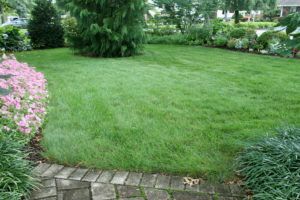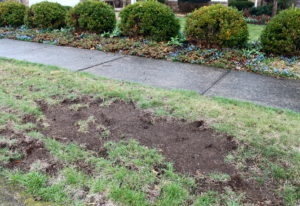Don’t Feel Bad about Your Lousy Lawn
April 30th, 2019
This is the time of year when your lawn is going to look about as good as it’s going to get.
But don’t feel bad if it’s not measuring up to the ideal that marketers conjured starting in the 1950s.
Sporting that pristine green carpet takes a lot of effort, input, and expense.
As if I have to tell you, much can wrong with a lawn in central Pennsylvania.
So many of our yards have lousy soil to start with. It’s often clayish, shale-laden, or just a few inches of barely-passable “topsoil” spread on top of graded, packed subsoil.
Grass is a plant, and like any plant, the roots need to penetrate the soil, have adequate oxygen and drainage, and be able to mine enough nutrition from the soil to feed the top growth.
The compacted hardscrabble lurking in so much of suburbia makes all of that iffy. Odds are you have one big strike against you before you ever plant your first little grass seed.
Then there’s the weather. We’ve always had erratic swings, but like most of the world, our extremes are getting “extremier.”
We can get long strings of dry heat at triple-digit levels, or like last year, incessant soakings.
Winters can hit 70 degrees one week and go under zero the next. Spring seems to show up, only to nose-dive back into winter.
Like people, grass does best with gradual change and predictable conditions. Our weather has been more of a wild ride lately than ever.
The simple fact that a lawn is made up of one kind of plant – cool-season grasses – is another big strike.
Most of our lawns are a blend of perennial ryegrass, Kentucky bluegrass, and fine fescue, and increasingly, 100 percent tall fescue.
On top of that, home gardeners usually buy cheap and under-performing varieties of those grass types – not the good stuff that places like golf courses and Beaver Stadium invest in.
Read George’s article on why variety makes a big difference and how to find the best ones
Lawns are essentially monocultures, which in the evolution of nature, is bad news.
Planting all of one thing might be easy maintenance and good for that formal, uniform look, but it’s bad when something comes along that’s detrimental to that singular choice.
In the case of lawns, that would be grubs, sod webworms, armyworms, and voles, not to mention diseases including red thread, rust, dollar spot, brown patch, and sooty mold.
Any one of those can undermine or even kill a lawn. To a grub, hatching into a half-acre of nothing but grass is like a buffet from Heaven.
In diverse plantings like a mixed ornamental garden, you’re skirting catastrophe by taking advantage of the fact that no one pest or disease targets everything.
Most pests or diseases target only one or a few types of plants. So, the more different stuff you plant, the more different attackers it’s going to take to really make a dent in your effort.
The most overlooked strike against lawns is that we assume it should grow well everywhere. Not true.
Turfgrasses are sun-lovers that need at least four to six hours of sunlight a day. They also don’t do well in constantly wet or compacted conditions, and they really don’t like competition from big tree roots.
Yet we plant and expect grass to do as well in the shaded back yard as in the scorching front yard.
We expect it to grow in wet or dry, on steep slopes with virtually no soil, and under ever-enlarging shade trees where it’s clear whose roots are winning the battle for moisture and nutrients.
Sometimes, it’s best to give up on grass, especially when conditions have changed that no longer support it. Other plants and groundcovers are available that will better suit the conditions that aren’t working out so well for your grass.
Read George’s article on shrinking the lawn
As Kenny Rogers sang, you have to know when to fold ‘em… or at least know when to lower your expectations (he didn’t actually sing that second part).
Finally, our “operator errors” are often merely the more noticeable final blow to all of these more subtle set-up troubles.
We mow too close, over- or under-fertilize, kill microbial life with pesticides, worsen compaction with foot and tractor traffic on soggy soil, and encourage shallow-rooting by irrigating often and lightly.
Like I said, don’t feel bad if your green carpet isn’t so green or carpet-like. It’s not easy.
Read George’s PennLive article on 11 things that go wrong in the lawn and how to fix them
Read George’s article on how to go with “good-enough grass”









